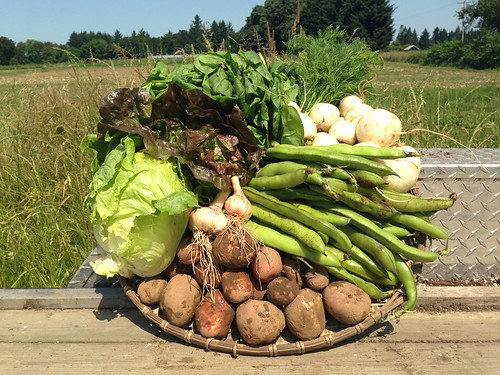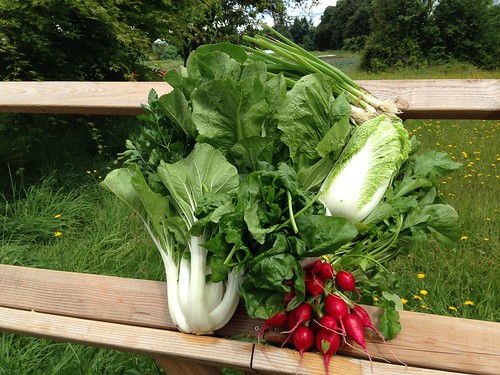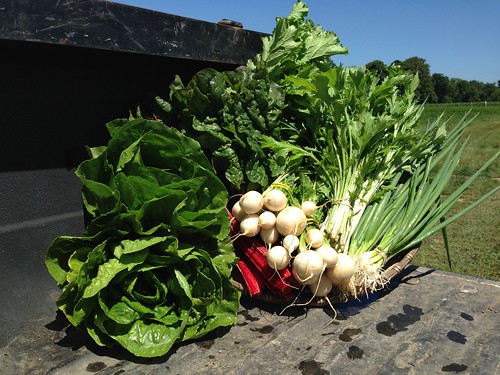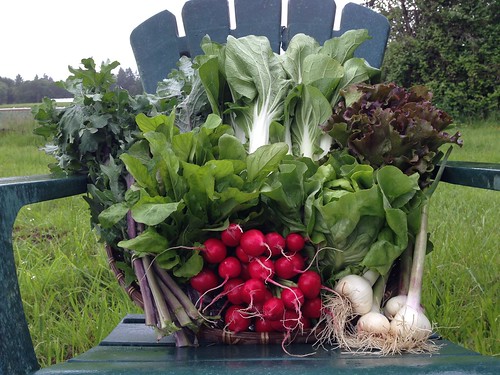This Week’s Share
Crop |
Family Share |
Half Share |
| Dill | 1 large bunch | 1 small bunch |
| Fava Beans | 4 pounds | 2 pounds |
| Garlic | 2 bulbs | 1 bulb |
| Lettuce | 2 heads | 1 head |
| New Potatoes, Red Gold | 4 pounds | 2 pounds |
| Spinach | 1 pound | ½ pound |
| Turnips, Hakurei | 3 pounds | 1 ½ pounds |
Share Notes
- Fava Beans: You will receive Fava Beans in your share this week and next week. They are a crop that is here and gone quickly, so enjoy them while they are around. WARNING– There is a rare genetic deficiency that affects some people and can lead to health problems if they eat fava beans. This condition is relatively rare and usually detected by childhood, but if you have never eaten fava beans before we recommend you check out www.g6pd.org to learn more.
- Lettuce: We have come into new beds of lettuce for this week’s harvest, and with that comes new conditions (and new bugs). The red butter lettuce in your share this week may show some signs of bug damage on the outer leaves.
- New Potatoes, Red Gold: Your Red Gold’s this week are young with tender skins. You may notice the potatoes are unwashed, and that is because we didn’t want to further peel their delicate “new” skins. Also, make sure to keep them refrigerated as they have not yet developed a thick and protective skin.
- Spinach: What a spectacular early season it’s been for spinach. Enjoy the distribution in your share this week, because it will be the last until the fall.
All Thursday Deliveries are taking place on Tuesday 7/2 this week due the 4th of July.
High Heat Pick-up Reminders
With the very warm temperatures forecasted for this week we wanted to offer of couple of reminders:
- Please pick-up your share in a timely manner on the day of delivery. This is especially important on high heat days in shares that have delicate greens.
- Do not leave your share in your car for any period of time on high heatdays. You share can go from perky to wilted in a matter of minutes in hot car.
Member Submitted Recipes
Have you found a great recipe or cooked something new with your share items recently and thought, “Wow! Other CSA members may really enjoy this?” We want to hear about your culinary successes and share them with our members. Email your recipes to us at csa@sauvieislandorganics.com and we’ll post them to the blog the next time that crop shows up. For the Facebook savvy you can go ahead and post the links directly to our Facebook page.
To kick off our member submitted recipes we have one from Kathleen in Northwest Portland. It’s a Madhur Jaffrey recipe for turnips cooked in yogurt. Kathleen says, “I made it just as printed except I left out the tomatoes. The type of yogurt I used was plain whole-milk. It was rich, creamy and savory, and also very easy.” Just click the link here if you are interested: http://www.saveur.com/












